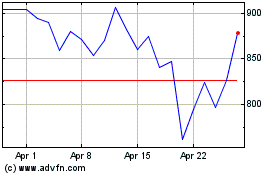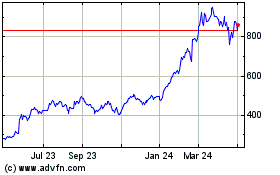COMPUTEX -- NVIDIA today announced that major
Taiwanese electronics makers are using the company’s technology to
transform their factories into more autonomous facilities with a
new reference workflow. The workflow combines NVIDIA Metropolis
vision AI, NVIDIA Omniverse™ physically based rendering and
simulation, and NVIDIA Isaac™ AI robot development and deployment.
By using the workflow to build digital twins for real-time
simulation of different factory layouts, manufacturers can optimize
space, processes and efficiency without costly physical
changes.
“AI for manufacturing is here. Every factory is becoming more
and more autonomous due to the transformational impact of
generative AI and digital twin technologies,” said Deepu Talla,
vice president of robotics and edge computing at NVIDIA. “With
NVIDIA Omniverse, Metropolis and Isaac, the industrial ecosystem
can accelerate its adoption of autonomous technologies, helping
advance operational efficiencies and lower costs.”
Electronics Manufacturers Adopt NVIDIA Technology to
Build Robotic FacilitiesDelta Electronics, Foxconn,
Pegatron and Wistron are using the reference workflow to build,
simulate and operate their robotics-enhanced facilities.
In a COMPUTEX keynote demo, NVIDIA founder and CEO Jensen Huang
demonstrated how Foxconn, one of the world’s largest electronics
manufacturers, develops digital twins of its factories on NVIDIA
Omniverse, a platform for virtually integrating 3D data from
leading industry tools such as Teamcenter from the Siemens
Xcelerator platform.
Omniverse helps Foxconn’s teams optimize equipment layout for
operational flow and AI cameras that will monitor worker safety
with NVIDIA Metropolis. Foxconn can then use the factory digital
twins as virtual training environments to simulate, test and
validate its autonomous mobile robots (AMRs) built on NVIDIA Isaac
Perceptor acceleration libraries, as well as its AI robot
manipulation arms, which are powered by NVIDIA Isaac Manipulator AI
models.
“AI and robotics are poised to revolutionize manufacturing,
enhancing safety on factory floors and driving significant
operational efficiencies,” said Young Liu, CEO and chairman of
Foxconn. “By integrating NVIDIA Omniverse, Metropolis and Isaac
into our operations, we can create sophisticated digital twins of
our factories to train robots, optimizing workflows with
unprecedented precision and reducing costs.”
Delta Electronics, a manufacturing leader in electronics and
IoT-based smart green solutions, is using NVIDIA Isaac Sim™, an
extensible robotics simulation platform developed on Omniverse and
OpenUSD, an open and extensible ecosystem for 3D worlds, to
virtually integrate its demo production lines. It then generates
physically accurate, photorealistic synthetic data for training
computer vision models for its NVIDIA Metropolis-powered automatic
optical inspection and defect detection solutions.
Pegatron, a Taiwan-based manufacturer and service provider, is
deploying an NVIDIA Metropolis multi-camera workflow and launching
a new suite of services that connects its NVIDIA Omniverse and
Metropolis factory digital twin workflow to NVIDIA NeMo™ and NVIDIA
NIM™ to help factory operators “chat” in real time. The
technological advances will help improve worker safety and
productivity in Pegatron’s massive factory network that spans over
21 million square feet and produces over 15 million assemblies per
month.
Wistron, a global leader in electronics manufacturing, has built
digital twins of its factories to accelerate the production of
NVIDIA DGX™ and NVIDIA HGX™ servers. Now, it is extending its use
of Omniverse to develop digital twins of the data centers that are
used to test and ensure the quality, performance and energy
consumption of newly assembled NVIDIA HGX systems.
Using NVIDIA Omniverse to simulate its facility and workflows
first, Wistron brought its factory online in half the typical time
— just two and a half months instead of five — and increased worker
efficiency by more than 50% through testing and optimizing
layouts.
“The combination of NVIDIA Omniverse and NVIDIA Metropolis
allows us to test new layouts virtually to identify new processes
and monitor real-time operations using live IoT data from every
machine on the production line,” said Alec Lai, president of global
manufacturing at Wistron. “Digitalizing our factory planning
process has reduced end-to-end cycle times by 50%.”
Ecosystem Expansion to Industrial
ApplicationsLeading Taiwan systems integrator Kenmec is an
early implementer of both Omniverse and Metropolis workflows and
services for major manufacturers such as Giant Group.
To help developers across the ecosystem, these digital twin
workflows are available as a reference architecture series.
Learn more about the newly available updates to NVIDIA
Isaac.
Watch Huang’s COMPUTEX keynote to get the latest on AI and
industrial digitalization.
About NVIDIANVIDIA (NASDAQ: NVDA) is the world
leader in accelerated computing.
For further information, contact:Natalie
HerethEnterprise CommunicationsNVIDIA
Corporationnhereth@nvidia.com
Certain statements in this press release including, but not
limited to, statements as to: the benefits, impact, performance,
and availability of our products, services, and technologies,
including NVIDIA Metropolis vision AI, NVIDIA Omniverse, NVIDIA
Isaac AI robot, NVIDIA Isaac Perceptor acceleration libraries,
NVIDIA Isaac Manipulator AI models, NVIDIA Isaac Sim, NVIDIA NeMo,
NVIDIA NIM, NVIDIA DGX and NVIDIA HGX servers, and NVIDIA HGX
systems; third parties using and adopting our technologies and
products, our collaboration with third parties and the benefits and
impact thereof, and the features, performance and availability of
their offerings; every factory becoming more and more autonomous
due to the transformational impact of generative AI and digital
twin technologies; and with NVIDIA Omniverse, Metropolis, and
Isaac, the industrial ecosystem being able to accelerate their
adoption of autonomous technologies, helping them advance
operational efficiencies and lower costs are forward-looking
statements that are subject to risks and uncertainties that could
cause results to be materially different than expectations.
Important factors that could cause actual results to differ
materially include: global economic conditions; our reliance on
third parties to manufacture, assemble, package and test our
products; the impact of technological development and competition;
development of new products and technologies or enhancements to our
existing product and technologies; market acceptance of our
products or our partners' products; design, manufacturing or
software defects; changes in consumer preferences or demands;
changes in industry standards and interfaces; unexpected loss of
performance of our products or technologies when integrated into
systems; as well as other factors detailed from time to time in the
most recent reports NVIDIA files with the Securities and Exchange
Commission, or SEC, including, but not limited to, its annual
report on Form 10-K and quarterly reports on Form 10-Q. Copies of
reports filed with the SEC are posted on the company's website and
are available from NVIDIA without charge. These forward-looking
statements are not guarantees of future performance and speak only
as of the date hereof, and, except as required by law, NVIDIA
disclaims any obligation to update these forward-looking statements
to reflect future events or circumstances.
© 2024 NVIDIA Corporation. All rights reserved. NVIDIA, the
NVIDIA logo, NVIDIA DGX, NVIDIA HGX, NVIDIA Isaac, NVIDIA Isaac
Sim, NVIDIA NeMo, NVIDIA NIM and NVIDIA Omniverse are trademarks
and/or registered trademarks of NVIDIA Corporation in the U.S.
and/or other countries. Other company and product names may be
trademarks of the respective companies with which they are
associated. Features, pricing, availability, and specifications are
subject to change without notice.
A photo accompanying this announcement is available
at:https://www.globenewswire.com/NewsRoom/AttachmentNg/dbef377a-3f39-4080-9a3e-73ad7ed97598
NVIDIA (NASDAQ:NVDA)
Historical Stock Chart
From May 2024 to Jun 2024

NVIDIA (NASDAQ:NVDA)
Historical Stock Chart
From Jun 2023 to Jun 2024
